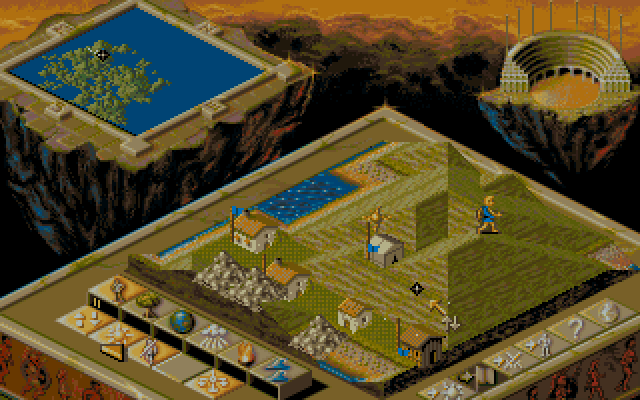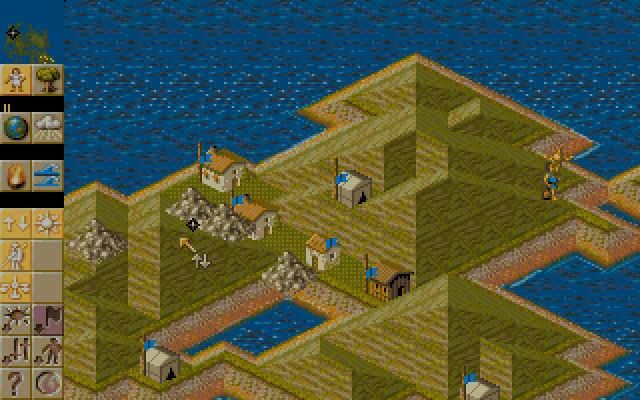In this post I said that Planitia was basically going to be a remake of Populous II.
The problem is that Populous II doesn’t really need a remake. Populous II still rocks. It’s still just as fun now as it was then (and runs well under DOSBox, for those of you interested in trying it out). Yes it does have some minor interface quibbles and yes it’s annoying when you start a new land to discover that your best school of god powers has been banned, but those don’t actually prevent the game from still rocking.
(And I know some people out there are saying, “Minor interface quibbles! The interface on Populous II was just as bad as the one on Populous!” Well, that means that you never hit F7 while playing the game, which changes the interface from this:

To this:

Nice, huh? It looks and feels very modern and is much easier to use than the default interface. Populous II was the game where the Bullfrog boys finally figured out how to lay out a GUI.)
Also, remaking Populous II meant giving up on the world simulation that had been a part of Planitia’s design since it’s inception. That felt wrong.
In fact, there’s a lot about Planitia’s design that has been feeling wrong. Planitia as originally designed was going to consist of four elements:
- A world simulation
- An economy-building element
- An RTS element, with direct control over military units
- World-shaking, screen-destroying god powers
And I am currently unhappy with how every one of those elements feels.
I began to understand this when I was implementing the RTS input scheme. While I wanted direct control over military units in Planitia, I also wanted the RTS elements to be very light. I thought I could get that by trimming down the number of unit types to three, but as I implemented the control scheme for the RTS elements I realized that even with a small number of unit types, the input system was going to be very complicated – and it had to be, because that’s what people would expect. You got band selection? Yes. How about double-clicking a unit to select that unit type across the screen? Yes. Holding shift to add to the current selection? Yes… Assigning groups to function keys? Uh…well…I didn’t want it to be that complex.. Come on, man, how can you leave that out?
This is a YouTube video of master Warcraft III player Grubby doing his thing. Listen to the first minute or so of the match. What you are hearing is everything that is wrong with modern RTS design.
And here I was re-implementing it. It felt tedious and wrong, but what other way was there?
Then I played Powermonger, and my eyes were opened.
Now I’m sure you’re thinking “What the hell?! Viridian, you just completely castigated Powermonger in your video blog!”
True, but Powermonger does some things very right, and one of those things is the General. The General is a single “handle” through which you control your entire army. Thus you do not need to click on each individual unit and tell each individial unit what to do click click click click click. Want to move your army? Click the General and give him a move order; the entire army moves with him. Want to attack something? Click the General, have him attack it. The soldiers in his army are smart enough to just do the right thing in most circumstances. A lot of the player’s work goes away – and a lot of my work goes away as well. No more having to make sure units are far enough apart that they can be individually clicked on. (Because being able to do that is so important…)
Now you might be thinking, “Well, that takes a lot of control away from the player and thus won’t be that fun.” No, it probably wouldn’t be that fun…if that were the only gameplay element in Planitia. But it isn’t. It’s one of a series of elements that will support each other and (hopefully) make for a fun experience.
Playing Powermonger also reminded me of my love of little people. I share Peter Molyneux’s love for little people and I’ve always wanted to make a game that featured them. Thus, the world simulation is coming back. I have no idea how I’m going to do it, but I will do it because I want my own little people. Besides, that technology will really come in handy when I move on to 3D RPG That Really Needs A Name.
As for the economy-building…again, I’m stealing from Powermonger. On every Powermonger map are several pre-created villages, each one running a village simulation. Most of these villages start out neutral and you always start your conquest by finding the weakest one and taking it over.
Hmmm…pre-set villages that provide resources after aligning with a side…sounds like control points to me!
But control points can feel very tug-of-war, and frankly I hate tug-of-war games. So I may make it so that once a village reaches a certain size, people leave it and start another village nearby if suitable terrain can be found (and that’s your job, of course). So while there are initial control points you can also make your own if you can hold out long enough. That feels better. Remember, always give the player a way to trade time for skill (at least against the computer).
It’s weird…these decisions feel good. They feel right. They make me want to work on Planitia full-bore again. Will things change? Probably. But I feel like Planitia’s design has gelled now, which is something I frankly thought would never happen.
And goshwow…
When you know more about what it is you like about these games specifically, then a design will start to form.
You were right, Dave!

Excellent post! I can’t wait to see the end result, but I love going along for the ride.
Thanks! I can’t wait to see the end result either…if only because that will mean I can do something else with my evenings 🙂
On what is wrong with RTSes.. I bought starcraft and brood wars a week ago, since I never played the games.
After the three first levels I dug up the cheat codes.
I mean, ok, games are meant to be a pleasant way of wasting time, but still, every now and then a mission comes along where the goal is to wipe out all enemies. Which means basically:
1. Build base next to resources
2. Harvest resources
3. Eventually, run out of resources
4. Wipe out enough enemies to reach the next field of resources
5. Repeat ad nauseum.
Instead, in most levels my strategy was such that for each race I played along far enough to figure out how to create a tough flying unit and then pumped out a hundred of them. Still took several evenings to finish!
I got hold of this game several days ago, im not sure what happened to those days… this game can suck you in.